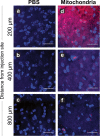Mitochondrial dysfunction in neurological disorders: Exploring mitochondrial transplantation
- PMID: 33298971
- PMCID: PMC7683736
- DOI: 10.1038/s41536-020-00107-x
Mitochondrial dysfunction in neurological disorders: Exploring mitochondrial transplantation
Erratum in
-
Author Correction: Mitochondrial dysfunction in neurological disorders: exploring mitochondrial transplantation.NPJ Regen Med. 2021 Mar 2;6(1):13. doi: 10.1038/s41536-021-00125-3. NPJ Regen Med. 2021. PMID: 33654099 Free PMC article. No abstract available.
Abstract
Mitochondria are fundamental for metabolic homeostasis in all multicellular eukaryotes. In the nervous system, mitochondria-generated adenosine triphosphate (ATP) is required to establish appropriate electrochemical gradients and reliable synaptic transmission. Notably, several mitochondrial defects have been identified in central nervous system disorders. Membrane leakage and electrolyte imbalances, pro-apoptotic pathway activation, and mitophagy are among the mechanisms implicated in the pathogenesis of neurodegenerative diseases, such as Alzheimer's, Parkinson's, and Huntington's disease, as well as ischemic stroke. In this review, we summarize mitochondrial pathways that contribute to disease progression. Further, we discuss pathological states that damaged mitochondria impose on normal nervous system processes and explore new therapeutic approaches to mitochondrial diseases.
Conflict of interest statement
M.R.L. owns stocks of eLoupes, Inc., and Cerebrotech Medical Systems, Inc. The rest of the authors declare that there are no competing interests.
Figures



References
-
- Frey TG, Mannella CA. The internal structure of mitochondria. Trends Biochem. Sci. 2000;25:319–324. - PubMed
Publication types
Grants and funding
- R01 EB020147/EB/NIBIB NIH HHS/United States
- R01EB020147/U.S. Department of Health & Human Services | NIH | National Institute of Biomedical Imaging and Bioengineering (NIBIB)
- R21 EB024323/EB/NIBIB NIH HHS/United States
- R01 NS105692/NS/NINDS NIH HHS/United States
- FUS878/Focused Ultrasound Foundation (Focused Ultrasound Surgery Foundation)
LinkOut - more resources
Full Text Sources
Other Literature Sources
Medical

